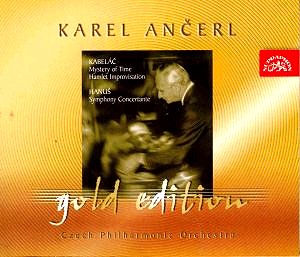Supraphon
lacks nothing in courage. Here in their
prestigious Ančerl Gold Edition
they choose to place together
three works that previously have been
coupled with more popular pieces. The
received commercial 'logic' is sweetener
and pill. Here there is no sweetener.
Perhaps the Czech company is relying
on what you might call 'collector momentum'.
After all won't collectors want to get
every one of these Gold Editions and
ensure that there is no gap in the numbers?
Of course for explorers
of rare repertoire such series offer
rich pickings. They will have no compunction
about picking up odd discs from the
series to populate their shelves with
recordings of Pauer, Vycpalek, Dobias
and others. Later volumes in this series
include the Kabelac Symphony 5 (SU3701-2),
Burghauser Seven Reliefs and
Dobias Symphony 2 (SU3700-2), Krejci
Symphony 2 and Pauer Bassoon Concerto
(SU3697-2), Vycpalek Cantata of the
Last Things of Man (SU3695-2), Borkovec
Piano Concerto 2 (SU3690-2), Vycpalek
Czech Requiem and Macha Rychlic
Variations (also on the all-Macha
collection from Arco Diva). That's about
six discs out of the 42 volumes in the
Ancerl Gold Edition.
Miloslav Kabelac
began composing in the 1930s and
his formative experiences during the
Nazi occupation and the Soviet regime
included the suppression of his works
with varying degrees of thoroughness.
The Mystery of Time begins
with the merest susurration. The effect
is rather like the shadowed murmurings
of Ives' Unanswered Question.
From about 7.00 (and later at 14.53)
the music takes on a stronger rhythmic
interest sounding Sibelian (though the
notes suggest Janáček)
rising to brazen piercing brass protests.
The chesty and hoarse brass writing
at 10.12 hints at familiarity with Suk's
Asrael. At the climax
at 13.00 and 18.11 the fate motif from
Beethoven 5 is alluded to. This is music
riven with conflict yet fitfully heroic
in character as at the magnificent writing
for high pealing trumpets (19.06). A
more serene tone is struck by the solo
violin in the last few minutes of this
impressive piece. The solo line yet
manages to avoid undue sweetness. There
is something toiling about that solo
voice rather than utterly at peace.
Kabelac made time the
subject of several of his pieces. Such
elitist philosophical obsessions were
anathema to the communist state - another
reason why his music was officially
stigmatised. The work was premiered
by the same forces as here on 23 October
1957.
Ten years later Kabelac
turned to the Hamlet Improvisation.
It was premiered in 1964 by the Prague
Symphony Orchestra conducted by Alois
Klima (whose Supraphon recording of
the Suk War Triptych should be
reissued - does anyone out there have
the LP?). It was written in Shakespeare's
400th anniversary year. Again the solo
voice of the violin can be heard but
the context is more challenging than
that in The Mystery of Time.
The fabric of the piece shows the influence
of Messiaen. At times there is also
an Egdon Heath chill about it.
Moods shift mercurially while questionings
and misgivings challenge the listener.
It is as if we are granted an insight
into Hamlet's disordered mind. This
is a troubled piece with a tendency
to fragmentation rather than long lines
(except in the solo violin) and with
inventive patter from the percussion.
A softer sentiment enters at 7.38 (Ophelia?)
with a soaring insistent theme for the
strings. Once again the work is given
coherence and logical momentum by the
return of the solo violin (underpinned
by the bassoon) at the close.
Both Kabelac works
avoid serialism and the dodecaphonic
method but, especially in the Hamlet
work, are happy to grasp dissonance
as part of the expressive armoury. Kabelac
is not afraid to use repetition and
subtle transformation of material to
bring us closer to his language.
Jan Hanus won
the Dvořák
Prize in 1954 for his Symphony
Concertante. It was written
during the long ascendancy of the socialist
cantata exhorting conformity and exulting
in the praise of Stalin and his fledglings.
However what we find in the Hanus work
is a piece with decidedly
serene inclinations - quite the opposite
of Kabelac. It sounds positively Gallic
with shades of the Poulenc Organ Concerto
yet not gargantuan Gothic. The confident
string writing blends in the style of
Dvořák from the Seventh and Eighth
symphonies. The harp plays a
prominent role throughout acting as
an assured orator at every step. It
was a brave choice to put the harp up
against the organ. Hanus's writing is
not desperately original but it is extremely
effective within the bounds of Tchaikovsky
and Ravel. The fugal finale is similar
to the final section of Britten's Young
Person's Guide. Although things
begin to become structurally ramshackle
toward the end it would pair nicely
with William Alwyn's Lyra Angelica
and I am sure would have appealed
to Alwyn.
I wonder if he ever heard it. The Hanus
is dedicated to Ančerl. Its premiere
took place in Brno in 1956 conducted
by Otakar Trhlík. Ančerl made this
recording in 1957.
The notes are good
although I would have liked more biographical
background on the composers. Recording
quality is at its least plush, though
still adequate, in the Hanus.
Rob Barnett
